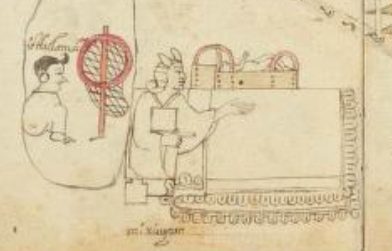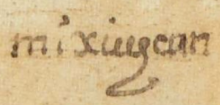Mixiuhcan (Azca18)
This iconographic example of the place name Mixiuhcan (perhaps “Place of Births”) shows a group of semantic indicators pointing to midwifery activity. These elements include a profile view of a child in a tan carrying frame or bassinet with red bowed pieces of wood curving over the top of the child. Below the child is a bird’s eye view of a large, folded, and fringed blanket (perhaps fringed with feathers). Next to the blanket is a woman with the neaxtlahualli hair style and a huipilli with a large rectangle reinforcing the base of the V-neck. Her arms are raised as though she is actively involved in birthing babies. She is apparently a midwife (perhaps a ticitl).
Stephanie Wood
The gloss explains that this scene refers to the toponym Mixiuhcan. Perhaps this could be called a hieroglyph rather than a simple example of iconography. There is a “Mixiuhca” today that is part of Mexico City. The presence of a blanket seems to suggest European cultural influence.
Stephanie Wood
mixiuhcan
Mixiuhcan
Stephanie Wood
post-1550, possibly from the early seventeenth century.
Jeff Haskett-Wood
nacimiento, bebés, partería, partos, topónimos, pueblos, nombres de lugares, axtlacuilli
mixihui, to give birth, https://nahuatl.wired-humanities.org/content/mixihui
-can (locative suffix), where, https://nahuatl.wired-humanities.org/content/can-2
posiblemente, “Lugar de Partos”
Stephanie Wood
The Codex Azcatitlan is also known as the Histoire mexicaine, [Manuscrit] Mexicain 59–64. It is housed in the Bibliothèque Nationale de France, and hosted on line by the World Digital Library and the Library of Congress, which is “unaware of any copyright or other restrictions in the World Digital Library Collection.”
https://www.loc.gov/resource/gdcwdl.wdl_15280/?sp=18&st=image
The Library of Congress is “unaware of any copyright or other restrictions in the World Digital Library Collection.” But please cite Bibliothèque Nationale de France and this Visual Lexicon of Aztec Hieroglyphs.


